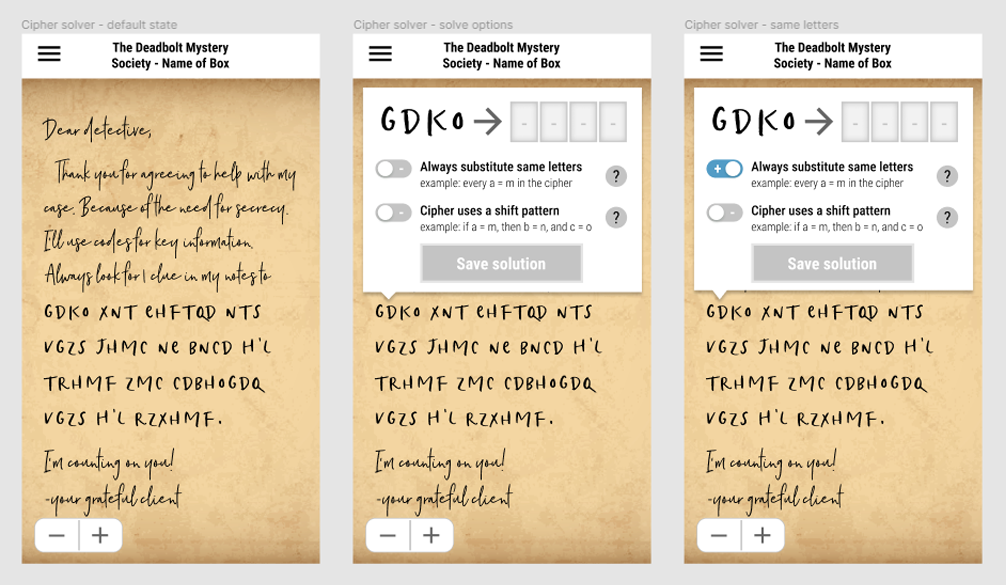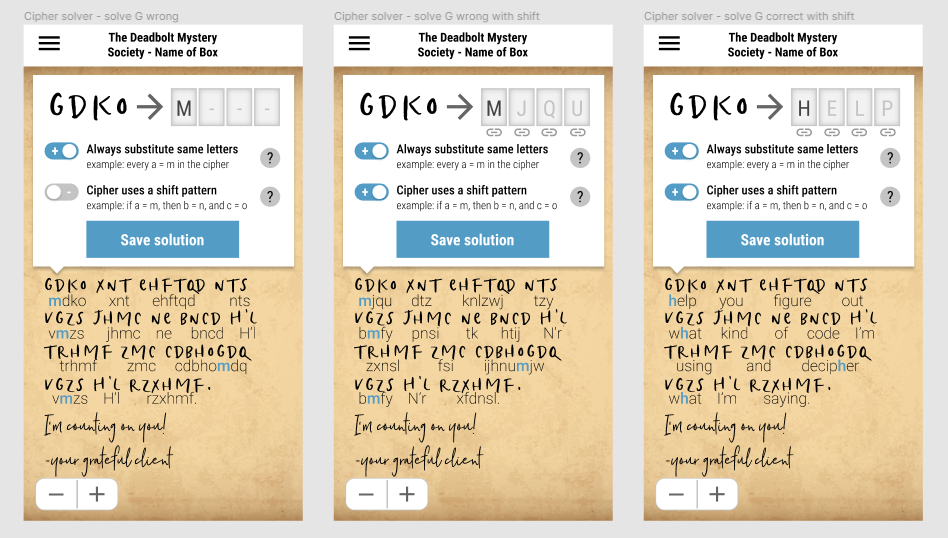Case Study
Mystery Game Design System – Cipher solver
In mystery boxes with higher degrees of difficulty, game designers often include ciphers as a fun and challenging element. My component balances a digital tool to help keep track of the solving process, without doing the hard work of code-breaking for them.

Component objective:
My vision for the Cipher Solver component is not an app-based version of code-breaking tools like players can find on a site like dCode. What I wanted is more of a solution tracking tool to help players apply their own logic and code-breaking skills to ciphers they find in mystery boxes, with some lightweight ways of making that process easier once they start testing out their solution.

Design challenges:
The biggest challenge with this component revolves around setting strong expectations. Expectations of what the “cipher solver” can do, but also what it can’t do.
If players are working on a Caesar cipher, I didn’t want them thinking the tool would help them brute force every alphabetic offset and come up with a solution. But if they’ve solved a letter within the cipher, or found a clue telling them the offset is “-8”, the cipher solver should help them apply their solution without manually having to apply a replacement for every letter in their ciphertext.
I also wanted to keep terminology simple and straightforward in case players aren’t well-versed in code-breaking terms or specific cipher encryption methods. So rather than asking players if they think their cipher is asymmetric, the app prompts them to indicate if they will always substitute a letter for the same letter. (Will “a” always equal “m”?) Instead of asking if their puzzle contains a Caesar cipher, the app prompts them to indicate if letters are shifted. (If m = a, does n = b?)
If players say that yes, both of these conditions are true, then providing any part of the solution will apply their logic to the rest of the puzzle.
As shown in the example screens, a critical element of the cipher solver component will be contextual help guiding players on what types of ciphers they might encounter and how the tool will support them.
The other major challenge for a component as complex as this is one of simple usability and intuitiveness. Solving ciphers is a complex task, so how do we make this as easy as possible, while still preserving the immersion and challenge of the puzzle itself?
While again, this component will need significant testing, my hypothesis is that by focusing players on a single word at a time, and applying their solutions according to specific rules they provide, the component can walk the fine line between helpful and challenging.
The final significant challenge will come from the administrative side, even more so than most components, when mystery box designers need to implement the component for each cipher puzzle. It needs the versatility to support a wide variety of cipher methods, but also visual presentations of those ciphers to fit with the theme of the game.
Other components:
- Introduction: Project overview
- Screenflow: Tracking mystery boxes and buying new ones
- Screenflow: Mystery box home screen and component list
- Component: Maps + annotation functionality
- Component: Locks (2 variants)
- Component: Cipher solver (THIS PAGE)
- Component: Image puzzles (2 variants – PENDING)
- Component: Logic puzzle grid (PENDING)
- Component: QR Code scanner (PENDING)